In this book, Moti Chandra compiles an enormity of information about ancient Indian courtesans organized into certain periods/locations and their literatures. By the sheer number of places and locations, Chandra’s book resists a singular or one-dimensional reading of the life of ancient Indian courtesans.
From the Preface
“The institution of courtesans in ancient India in its social setting has not yet received as much attention from scholars as it deserves. Courtesans in ancient India did not merely serve the baser needs of society but were also a symbol of culture and ars amoris. Around them moved interesting characters such as rich merchants, bankers, and the vitas (rakes). In this way a courtesan became an important part of Indian society. So far as literature is concerned, courtesans, in spite of their perfidies, were considered an urban institution which gave an impetus to arts and the life of luxury….
The institution of courtesans is a distinguished feature of developed urban society and, therefore, in Vedic and post-Vedic literature, though the courtesans are mentioned casually, we hardly know much about their life and accomplishments. In Buddhist literature, however, we are face to face with the highly developed institution of courtesans…. In Jain literature as well, courtesans have received attention and their achievements have been noted…. In the Mauryan period, however, the organization of the courtesans became highly complex and the state devised a set of rules which governed their conduct….
However, the best account of courtesans is obtained in the Kamasutra of Vatsyayana which goes into great details in drawing a very correct picture of the institutions of courtesans, the clients who visited them, the low characters who either helped the courtesans and their clients and hangers on, their amusements, the picnic parties to which they proceeded with their lovers, periodic festivals in which they participated, their acts of piety and virtue and vices.”
Critiques
Although this work is very thoroughly researched and informative, The World of Courtesans is not without its biases. In “Re-Inscribing the Indian Courtesan: A Genealogical Approach” (see our citation and download the .pdf here), Meenal Tula and Rekhal Pande observe that Chandra speaks of courtesans’ sexuality in a demeaning and even anxious way. They argue that in doing so, The World of Courtesans “contains, disciplines, and ‘silences the courtesan subject,'” common features of scholarship on the devadasis. Consider the following quote:
“Moti Chandra, in his study The World of Courtesans (first published in 1976), attempts to provide a compilation of the various kinds of roles played by the courtesan women since the Vedic period. He talks about their sexual, ritual and sacred roles and, citing various sources, catalogues the various terms that have been employed for the courtesans over the ages—ganika, khumbhadasi—and the hierarchies between these various terms. At the same time, the book is framed by a narrative that sees courtesans as women who ‘served the baser needs of society but were also a symbol of culture and arsamoris.’ At the same time, while Moti Chandra sees these women as morally base and ‘living the life of shame’, he nonetheless reveals a deep anxiety towards the ‘crafty’ and ‘worldly-wise’ ways of these women: ‘…courtesans tempt(ed) their lovers, perhaps depriving the rich Aryans of a part of their possessions in cattle and gold.’ Further, Chandra seeks to configure the courtesan women primarily according to their sexual function, seeing it as the sole aspect that ‘explains’ all dimensions of the courtesan, sexual, cultural and political. In this sense, Moti Chandra’s history of the courtesan women does not explore the complexities of the inter-relationships between these women and the extant patriarchal structures, even though it is a ‘women’s history’.”
Table of Contents
- Courtesans in Vedic, Pauranic, and Smiti Literatures
- Courtesans in Buddhist Literature
- Courtesans in Jain Literature
- Courtesans in the Mauryan Period
- Courtesans in the Kamasutra and Natyasastra
- Courtesans in the Gupta Period
- Courtesans and Goshthi in Sanskrit Drama
- Courtesans in Mediaeval Kashmir
- Courtesans in Mediaevil Times in Other Parts of India
- Courtesans in South India



